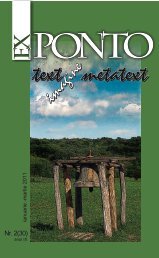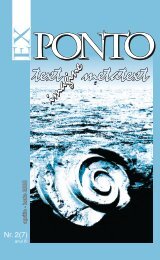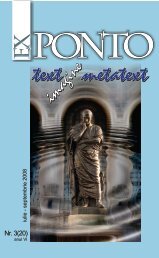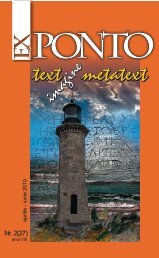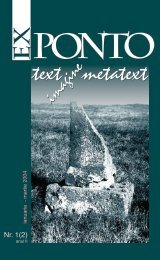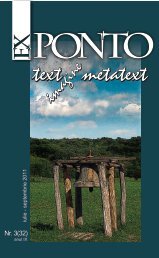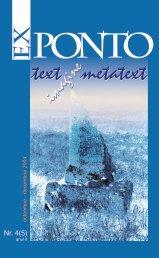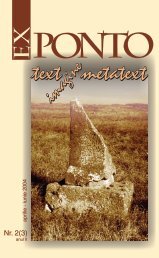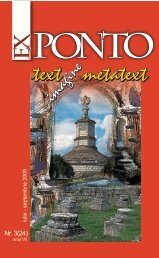validate or invalidate the choices, which come up during the act of writing andthus makes the authorial intention into a “textual force”. He does not considerthat one explicitly written choice eliminates the previous attempts; for Gabler,writing another version does not mean that it annuls the others. His experimentfails to prove its scholarly eficacy since as his most critical opponent, JohnKidd, points out that Gabler’s errors make his point useless: a genetic editionshould be errorless, otherwise it cannot tell the story of any creative process.Instead, it raises suspicions about the whole text and the accuracy of editor’sinterpretations. Moreover, the synoptic edtion of 1984 became the startingpoint of the 1986 too vainly named “The Corrected Text.” Kidd underlines thefact that indications of the places where erasures occurred are erroneous:The 1984 apparatus records erasures that never existed and misses evenmore that do. If one goes to Philadelphia and holds up to a lamp each leaf ofthe second and shortest episode of the book, "Nestor," one can find in minutesten erasures not detectable in the facsimile, and not recorded in 1984. Twentypages from the start of the book and the transcriptions are in a mess. 3Displaying the various forms of textual concreteness as they appear inmanuscripts leaves the other authorial revisions that may come at a laterpoint during the printing process unreasonably aside. Gabler considers thatthe author’s mission ends when the manuscript is finished and submitted forpublication. Afterwards, authorial interventions do not seem to count for him, asif authorial intentions cannot be expressed but in a handwritten manuscript.In genetic editions, text augments itself by adding all contextual changesas if the history outside the text may have its share of the text by illuminatingcertain meanings: he refers to Pound’s Canto LI and the corrections madeafter July 1934 which can be read as shifting from initial authorial intentions toanother set. Gabler thinks that by juxtaposing these two sets one can figureout the “multiple directions and dimensions of meaning” (Gabler 115). In thiseditorial system, text becomes summa texturae, and inerent erasures, as longas they are legible, play an active part in the editorial game.Looking under the ErasureInterested in the physicality of the text, McLeod surveys Bridges’ editionsof Hopkins and the dialog between the two referring to Hopkins’ notations ofrhythm, accents, or punctuation. He also analyzes the alterations of the sonnetshapes produced by the editor and the significance each shape bears. Theway Bridges chose to cut Hopkins’ texts to fit into his notebook, on the onehand, and Hopkins’ answer to these remodellings, on the other, represent twodifferent responses to the body of the text. Obviously, for Bridges, titles, blanksbetween octaves and sestets, or other signs that accompany the text itself donot belong to the text. Thus, they can be cut, deleted, or trimmed according tohis Procustean logic: the text should fit the page irrespective of how much ofthe paratextual information is left out or where the text is mutilated and spliton two different pages. As for Hopkins, although he partially accepted theelimination of his “system of marks, all indicating the speech-movement” 4 ,he wrote back to his editor friend to reassure him that, in spite of their lackof consistency, his notation should be preserved to “mark where the readeris likely to mistake.” 5 The different sizes of colons used by Hopkins in PiedBeauty (1877) to focus the reader both on what comes after and on the rhymeEx Ponto nr.3, <strong>2006</strong>81
Ex Ponto nr.3, <strong>2006</strong>they underline by their presence have been equalized deleting any potentialresponse and obliterating authorial intentions, as well. In this case, there isno doubt that the editor intervened where he considered that his actions weremarginal but effective for consistency’s sake. Why should consistency be partof the literary cannon even against authorial intentions? Bridges’ stubbornessof reshaping Hopkins’ sonnets after the poet had redesigned their patternevidences the editors’ need of a coherent system and the author’s desire ofits novel, even irregular, appearance.In search of authorial intentions, McLeod recovered Donne’s text ofTo his mistress going to bed from under the ink layer. He built a plausibleargument that the Rosenbach Manuscript 6 can be a holograph version of theepithalamion because, as he will reveal, it contains the most direct expressionof the nakedness of the characters at the end. McLeod’s supposition thatthe covering of the text was caused by the uncovering of lovers’ bodies iscredible: he presumes the text was deliberately hidden “for the sake of thereader’s modesty or the censor’s prudery – or for the poem’s being deemedpornographic.” He also suggests that either by spilling ink on the text or byrejecting its publication, as it happened in 1632 when this text was deniedpublication, the poem has encountered several kinds of deletion. Usingtechnology (a Hamamatsu infrared video camera, a Scion Frame Grabber, anda computer), a photographer rescued the text by playing with contrasts andframings. The “hole text”, as it is called by McLeod because of the numerousgaps it contains in spite of the technological efforts involved, inspired its editorto create two versions: the first is an image, incomplete from a textual pointof view, the second, as it might have originally appeared, is refilled with thesigns that once might have rested on the page. Perfectly aware of the risks,McLeod pursues his restoration in order to draw attention to its unreliablenature and to subversively provide his own version. Actually, his attempt canbe compared with the cleaning of the Sistine Chapel, procedure that not onlyreinvigorate the colors, but also erase the long history of the (mis)usage of theplace. While commenting on this edition of a deleted text in connection withthe concept of authorial intention, one may face a great dilemma: to recoverthe text means to restore the authorial intentions as they were embodied in thetext, or to accept the irremediable deletion of the text, which means that thetext is not physically indestructible, and consequently, the author’s intentionsare neither, since they are located in the text.McLeod’s concern about the original shape of texts indicates the fact thathe relates the initial concrete realizations of poetic works to their authors’intentions, on the one hand, and to their potential significance, on the other.Considering the distinction made by E.D. Hirsch between meaning asembedded in the text by the author, and significance as what is revealed byreaders during the act of reading, 7 one may assert that McLeod is especiallyinterested in delivering both the meaning inscribed by the author in the shapeof his work and in the significance readers can achieve through the textualbibliographical aspect. Author’s intentions are located in the form of the textas well as they are in its conceptual content. To look at the first printed versionduring the author’s lifetime and at the other contemporary editions, or at itsold versions, closer to the original pattern, represents a more exciting reading,which provides more than the immediate reading of a piece of literature. Itprovides a mediated knowledge about the textual culture to which the textbelongs. Text is seen as a significant object in itself and its different printed82
- Page 2 and 3:
Ex PontoText/imAgine/metatextNr. 3
- Page 4 and 5:
SUMAR♦EditorialOVIDIU DUNĂREANU
- Page 6 and 7:
editorialOVIDIU DUNĂREANUScriitoru
- Page 8 and 9:
poezieIULIA PANĂ* * *Cum ar trebui
- Page 10 and 11:
* * *m-am trezit în astă diminea
- Page 12 and 13:
IOAN ŢEPELEAPoemele mirării care
- Page 14 and 15:
Mona Lisa pare a acoperi chiar şoc
- Page 16 and 17:
în schimb, asfaltul te dinamizeaz
- Page 18 and 19:
în care ai putea să îţi întinz
- Page 20 and 21:
Un ins orbecăia ca în visOchii -
- Page 22 and 23:
Şi în secunda următoareSă apar
- Page 24 and 25:
CLAUDIA VOICULESCURondeluriDoar ste
- Page 26 and 27:
OLIMPIU VLADIMIROVMulţumireTrec nu
- Page 28 and 29:
prozăFLORIN ŞLAPACO teribilă set
- Page 30 and 31:
Ah, a zis Aloisius, ia uite-l şi p
- Page 32 and 33:
viaţa multor fiinţe zaharisite, a
- Page 34 and 35:
crede în ce facem noi. Apoi, câte
- Page 36 and 37:
- Dar sensibiloasă mai eşti, se s
- Page 38 and 39: publicul avizat (şi nu numai) al u
- Page 40 and 41: Din somn mă scoală-n miez denoapt
- Page 42 and 43: Lumina cunoştinţii să-i facă ar
- Page 44 and 45: memorialisticăPERICLE MARTINESCUPa
- Page 46 and 47: asta este şi drama ţării mele, a
- Page 48 and 49: provocând pagube importante, deşi
- Page 50 and 51: formidabil, într-adevăr: nouă bo
- Page 52 and 53: 11 iulie Mâine dimineaţă plec la
- Page 54 and 55: locul lor, tejgheaua şi rafturile
- Page 56 and 57: cărui frunze fâşâiau în vânt
- Page 58 and 59: originalul de lângă mine - la sca
- Page 60 and 61: traduceri din literatura românăIL
- Page 62 and 63: Rituella fête met cet être en tra
- Page 64 and 65: elogios, recunoaşterea unanimă. P
- Page 66 and 67: Furtuni înnebunind azurul, scutur
- Page 68 and 69: Mă voi înzdrăveni cu mei proasp
- Page 70 and 71: Cu suflu-i arzător crăpând buzel
- Page 72 and 73: Marin Gherasim - Diptic, 1994, ulei
- Page 74 and 75: IIIMarin Gherasim - Kairos, 2001, t
- Page 76 and 77: Marin Gherasim - Aripă, 2000,ulei
- Page 78 and 79: imagineMarin GherasimUn spirit inte
- Page 80 and 81: Retrospectivă la Muzeul Naţional
- Page 82 and 83: invitat „ex ponto”CARMEN CHIHAI
- Page 84 and 85: vine din povestea lor. Or, noi avem
- Page 86 and 87: Paradoxically, the myth of the unfo
- Page 90 and 91: versions, even those which contain
- Page 92 and 93: tries to separate the editor’s do
- Page 94 and 95: ConclusionFrom the Platonic myth of
- Page 96 and 97: Fractalul este foarte aproape de pe
- Page 98 and 99: Conceptul de text matricial (aplica
- Page 100 and 101: Proximităţi şi diferenţe, unele
- Page 102 and 103: Citit retrospectiv, Ionescu nimere
- Page 104 and 105: avangardaPAUL CERNATÎntre extremel
- Page 106 and 107: Cu relativă simpatie „revoluţio
- Page 108 and 109: cu un cuprinzător eseu al d-lui Ni
- Page 110 and 111: *În paginile revistei Integral nu
- Page 112 and 113: la „stânga plasticei şi a liris
- Page 114 and 115: geri a separării dintre artistic
- Page 116 and 117: dar cu apucături de satir. Lukrezz
- Page 118 and 119: participa direct la strălucirea su
- Page 120 and 121: situaţii politice, a bravat fără
- Page 122 and 123: Portretul de anarhist, pe care şi-
- Page 125 and 126: Poate nu întâmplător, cel care-i
- Page 127 and 128: mari scriitori români contemporani
- Page 129 and 130: se uite la foaia de/ Hârtie, care-
- Page 131 and 132: la recensământ.)/ -Pe-astea să l
- Page 133 and 134: (…)// Peste câţiva ani/ A înce
- Page 135 and 136: Ex Ponto nr.3, 2006baston, indifere
- Page 137 and 138: cronica literarăNICOLAE ROTUNDCons
- Page 139 and 140:
Ex Ponto nr.3, 2006comentează în
- Page 141 and 142:
priveam pe furiş maxilarele descă
- Page 143 and 144:
Ex Ponto nr.3, 2006Nicolae Motoc pr
- Page 145 and 146:
VALERIA MANTA TĂICUŢURăpit pe ve
- Page 147 and 148:
Apelul la miturile precreştine est
- Page 149 and 150:
Ex Ponto nr.3, 2006şi scadenţa M(
- Page 151 and 152:
Ex Ponto nr.3, 2006cel al gepidei A
- Page 153 and 154:
Ex Ponto nr.3, 2006lizare discursiv
- Page 155 and 156:
Ex Ponto nr.3, 2006decât necesară
- Page 157 and 158:
Ex Ponto nr.3, 2006‹‹cochilie
- Page 159 and 160:
cronica literaturii străineADINA V
- Page 161 and 162:
Ex Ponto nr.3, 2006Titlul romanul a
- Page 163 and 164:
de a-l găsi pe cel care a salvat-o
- Page 165 and 166:
Ex Ponto nr.3, 2006158aservirii rus
- Page 167 and 168:
În mitul grec, odată cu suveranit
- Page 169 and 170:
Ex Ponto nr.3, 2006162nu e conţinu
- Page 171 and 172:
Un fenomen care pare pur occidental
- Page 173 and 174:
studii culturaleMARCOS FARIAS-FERRE
- Page 175 and 176:
Ex Ponto nr.3, 2006assume meaning i
- Page 177 and 178:
Ex Ponto nr.3, 2006in rapid transit
- Page 179 and 180:
Ex Ponto nr.3, 2006contingency of t
- Page 181 and 182:
production about the ‘internation
- Page 183 and 184:
Ex Ponto nr.3, 2006Dar peripeţiile
- Page 185 and 186:
Ex Ponto nr.3, 2006(24 dec. 1672 -
- Page 187 and 188:
Ex Ponto nr.3, 20061705, ambii ai P
- Page 189 and 190:
Ex Ponto nr.3, 2006Constantin Brân
- Page 191 and 192:
Ex Ponto nr.3, 2006‘separatist’
- Page 193 and 194:
Ex Ponto nr.3, 2006succedea pe tron
- Page 195 and 196:
al XVII-lea - pentru a ne limita do
- Page 197 and 198:
41Arhimandritul Neofit a ocupat fun
- Page 199 and 200:
o imagine cuprinzătoare a contribu
- Page 201 and 202:
Ex Ponto nr.3, 2006Din subcapitolul
- Page 203 and 204:
Ex Ponto nr.3, 2006Din primul studi
- Page 205 and 206:
să devină fiinţe sociale, căci
- Page 207 and 208:
sociologia cărţiiCONSTANTIN CIORO
- Page 209 and 210:
în biblioteci. Cronicarii literari
- Page 211 and 212:
Ex Ponto nr.3, 2006Lui Debussy îi
- Page 213 and 214:
Ex Ponto nr.3, 2006cumente preţioa
- Page 215 and 216:
Salonul Internaţional de carte „
- Page 217 and 218:
Ex Ponto nr.3, 2006scriitorii înş




